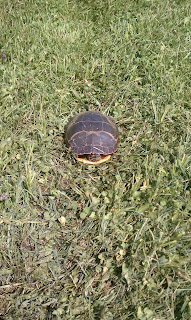 |
| Photo By: Olivia Riccio On the way to Ongley Pond, A Female Painted Turtle |
 |
| Photo By: Olivia Riccio Tadpole Sampled for Chytrid Fungus |
 |
| Photo By: Olivia Riccio Green Frog |
 |
| Photo By: Olivia Riccio How to Hold A Green Frog for Swabbing |
 |
| Photo By: Olivia Riccio Catching a Leopard Frog |
 |
| Photo By: Olivia Riccio Identifying a Leopard Frog |
Recently Batrachonchytrium dendrobatidis or chytrid fungus was found worldwide causing stress and even death to various amphibians, in particular frogs. Chytrid fungus is an invasive fungus that is quickly spreading towards the Northeast section of the United States. At White Memorial we are testing for the presence of chytrid fungus on frogs and salamanders at Ongley Pond, Mallard Marsh, and Duck Pond. We hope that we will find an answer to why chytrid fungus affects frogs and specifically why chytrid fungus kills amphibians in other parts of the United States but seems at this time to only cause stress to these northeastern inhabitants?
Tuesday, June 21, I had the pleasure to sample Ongley Pond on White Memorial for green frogs, leopard frogs, or really any frogs I could find! The weather was perfect for catching frogs; it was a clear, sunny 85 degree day. The procedure used to sample is non-destructive to these amphibians. Once the frog is caught by a net, the frog is held by their legs (the legs are the strongest part of their body and are usually used to escape!) and then the smooth side of the toothpick is rubbed on the frog's stomach, back, and the inside and outside of the legs (where the majority of the chytrid fungus is found). The toothpick is then soaked in a vial of ethanol and labeled. Each frog sampled is then described with any additional information needed in my field notebook. So far, I have sampled 6 frogs (it is hard to catch frogs especially with mosquitoes flying around your head!). 5 out of the 6 sampled were green frogs. One leopard frog (less common than the green frog) was sampled along with a tadpole (See Above). Hopefully, these samples will lead to some answers when they are sent to Yale University to be tested in the lab by Kathryn Richards-Hrdlicka , head of this research project. But, don't worry more frog sampling is on the way (if this rain ever stops)!

No comments:
Post a Comment